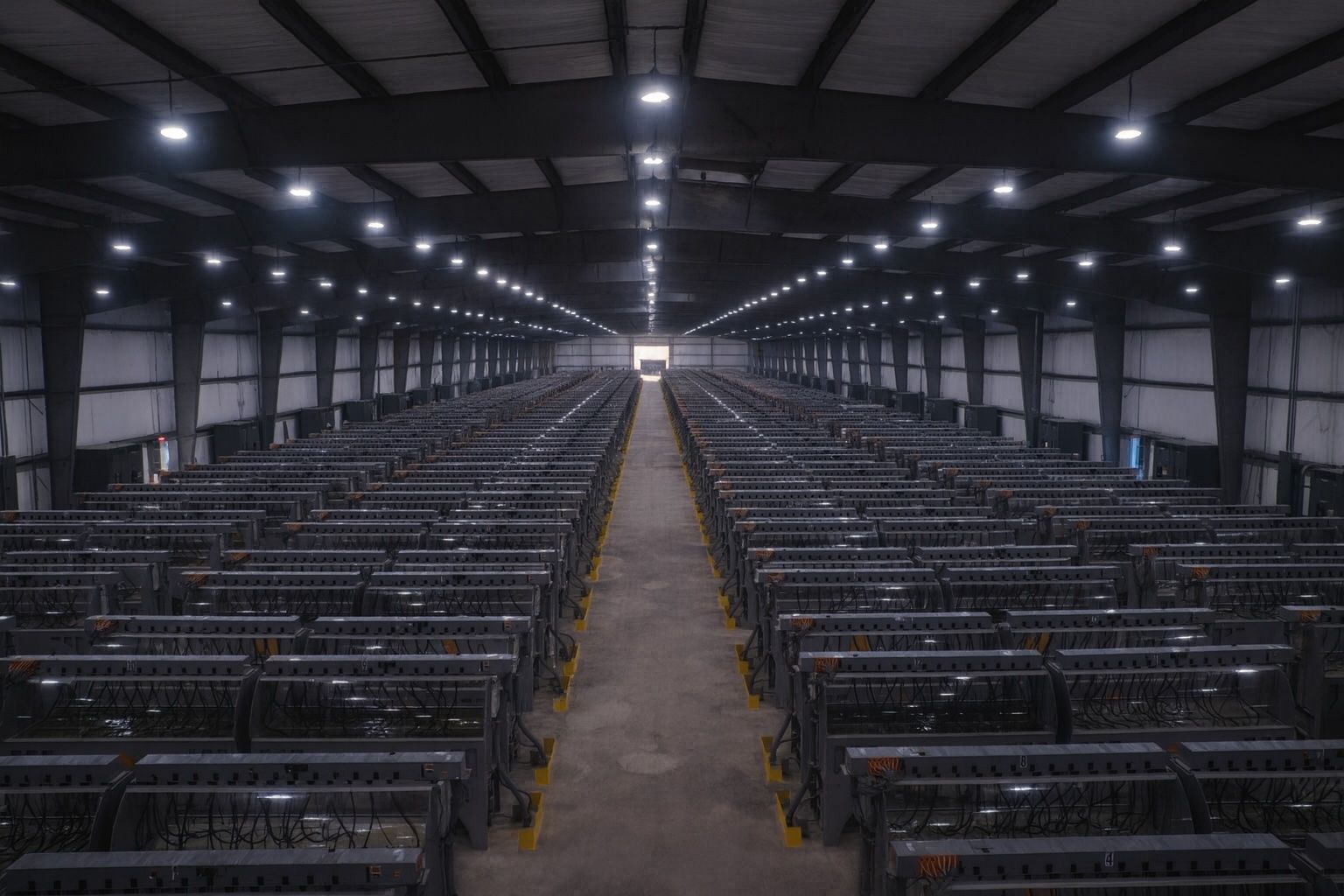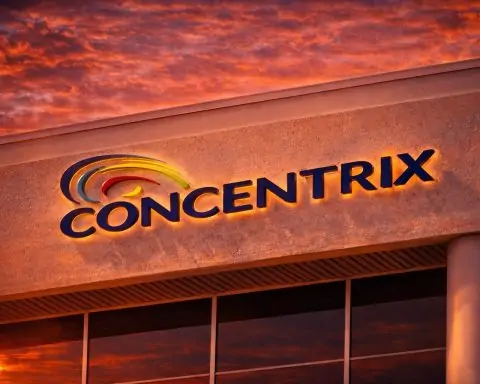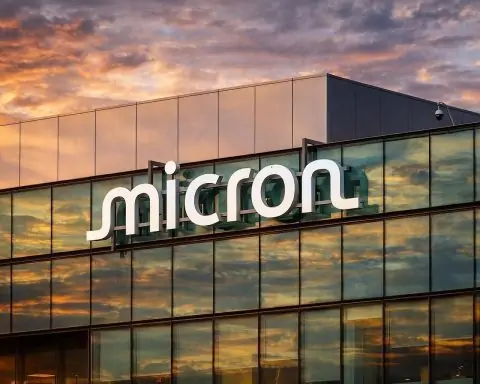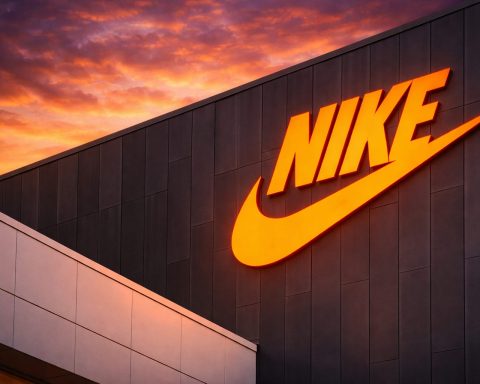Riot Platforms (RIOT) Stock Highlights as of October 26, 2025
- Bitcoin Surge Lifts Riot: Riot Platforms’ stock has spiked amid the broader crypto rally. Bitcoin blasted past $125,000 to new all-time highs in early October [1], and even after a mid-month pullback is hovering above $110,000 per coin [2]. This crypto boom sent Riot’s shares up roughly 11% this week alone – hitting around $22.3 at mid-week – before settling at $21.42 by Friday’s close (Oct 24), up 4.5% on the day [3]. The stock is now up roughly 40–50% year-to-date [4], vastly outperforming the broader market.
- Record Bitcoin Production & Profits: Riot is capitalizing on Bitcoin’s strength with record mining output. The company produced 477 BTC in August 2025, a 48% YoY jump, and another 445 BTC in September (up 8% YoY) [5] [6]. Riot sold 450 of August’s bitcoins for $51.8 million (at ~$115K each) [7] and 465 BTC in September for $52.6 million [8]. Soaring crypto prices fueled a blowout Q2 2025, in which Riot posted $219.5 million in net income (vs. a loss prior) thanks largely to a $470+ million mark-to-market gain on its hefty Bitcoin holdings [9]. Revenue more than doubled to $153M, and adjusted EBITDA hit $495M in Q2, as management noted “strong tailwinds in the price of bitcoin” driving unprecedented profitability [10].
- Low Costs, High Efficiency: Riot boasts some of the lowest mining costs in the industry, leveraging cheap power and energy credits in Texas. In August, Riot’s all-in electricity cost was just $0.026 per kWh after earning $16.1 million in power credits by curtailing usage during peak grid demand [11]. Even though the April 2024 Bitcoin halving doubled the cost to mine one BTC (to ~$49K, vs ~$25K last year) [12], Riot’s efficient operations and the current Bitcoin price well above $100K keep mining margins solidly positive. The company’s total hashrate has swelled to roughly 36 exahash/second (EH/s) – more than double its level a year ago – after aggressive expansion of its mining fleet [13]. Riot now holds about 19,300 BTC in its treasury (up 85% year-on-year) [14], giving it one of the largest Bitcoin stockpiles among miners.
- Analysts Bullish, Eye New Catalysts: Wall Street is growing optimistic on Riot. Macquarie just reaffirmed an “Outperform” rating (buy equivalent) on the stock this week [15]. Piper Sandler also boosted its price target from $18 to $25 on October 20 while maintaining a Neutral stance, citing Riot’s potential to partner with major AI/high-performance computing clients at its new facilities [16]. In fact, Riot is developing a large-scale data center platform to support AI and high-performance computing (HPC) workloads at its Texas sites, not just crypto mining [17]. Most brokerages already rate RIOT a “Strong Buy” as the company rides the crypto wave [18]. Some traders even speculate about a short squeeze – roughly 22% of Riot’s float is sold short [19] – likening Riot to a potential “next GameStop” due to its high short interest and momentum-driven gains [20]. While such enthusiasm reflects bullish sentiment, it also underscores the stock’s extreme volatility (beta ~4.6) [21].
- Competition and “AI Pivot” in Crypto Mining: Riot is among the top U.S. Bitcoin miners, but faces fierce competition. Marathon Digital Holdings (MARA), for example, mined 705 BTC in August and hodls an industry-leading 52,477 BTC vs. Riot’s ~19,300 [22]. Marathon’s deployed hashrate is now a massive 59.4 EH/s – far above Riot’s – aided by new wind-powered Texas facilities coming online [23]. Meanwhile, rivals are diversifying: CleanSpark (CLSK) shares surged 13% on Oct. 21 after it announced plans to build and operate AI computing data centers alongside its Bitcoin mines [24]. In fact, many mining firms (CleanSpark, Marathon, Riot, Hut 8, Cipher and others) have unveiled similar “pivot to AI” strategies, looking to repurpose mining rigs and power capacity for lucrative AI/HPC workloads as crypto rewards decline [25]. The news of miners expanding into AI set off a sector-wide rally this week – Riot’s stock jumped 11.2% to ~$22.28, and Marathon’s rose ~8%, in just one day on that trend momentum [26]. Investors clearly see opportunity in miners becoming broader digital infrastructure providers, not just crypto pure-plays.
Bitcoin Boom Sends Riot Stock to New Highs
Riot Platforms’ stock has been on a tear, directly tied to Bitcoin’s explosive 2025 rally. Bitcoin’s price shattered records above $125,000 per coin in early October [27], spurring a massive run-up in crypto-related equities. Riot – one of the largest publicly traded Bitcoin miners – saw its share price surge in tandem. This past week, as Bitcoin rebounded above $110K [28], Riot’s stock spiked roughly 10–12% to around the $22 level – marking a new 52-week high for the company. It closed Friday, October 24 at $21.42, up 4.5% for the day [29] and roughly 50% higher than where it started the year [30].
This dramatic rise far outpaces the broader market and even Bitcoin itself (which is up about 15% year-to-date) [31]. Riot’s rally accelerated during “Uptober,” a seasonally strong period for crypto. In early October, Bitcoin’s surge – fueled by optimism around looming spot Bitcoin ETFs and macroeconomic safe-haven demand – lifted the entire crypto mining sector. A MarketBeat report highlighted how miners and blockchain stocks were “riding the wave”, with names like Marathon Digital and Bitfarms up between 30% and 148% on the year [32]. Riot has participated in these outsized gains, benefiting from both its direct Bitcoin exposure and newfound investor enthusiasm for anything crypto-linked.
However, the ride has been volatile. In mid-October, global markets wobbled after a geopolitical shock (a surprise announcement of 100% tariffs on China) triggered a brief risk-off move. Bitcoin plunged from ~$122K to ~$104K in a matter of days, before bouncing back above $110K [33]. Crypto stocks, including Riot, mirrored these swings – underscoring their high beta nature. Riot’s 𝛽 (beta) is around 4.6, meaning it tends to be 4-5× more volatile than the overall market [34]. Case in point: within the first three weeks of October, RIOT shares whipsawed from the high teens to the low $20s, and saw nearly an 11% single-day jump on October 21 [35] followed by a few percent pullback. Traders should be prepared for this kind of turbulence. Despite the choppiness, the overall trajectory has been decisively upward in 2025 – a reflection of Bitcoin’s bullish trend and growing confidence in Riot’s strategy.
Robust Production, Revenues and Mining Margins
Riot’s fundamental performance has strengthened dramatically alongside the crypto market. The company is consistently mining more Bitcoin than ever before. August 2025 was a banner month – Riot produced 477 BTC in August, the most it’s ever mined in a single month (and up 48% from August 2024) [36]. It followed that with 445 BTC mined in September [37], which, while slightly lower than August’s output, still represented an 8% year-over-year increase and kept Riot on a record-breaking quarterly pace.
These production milestones are translating into surging revenues. Riot sold the majority of the bitcoins it mined during the quarter to realize cash for operations and growth. In August, for example, Riot sold 450 BTC at an average price of roughly $115,000 each, yielding $51.8 million in revenue [38]. September’s sales were even higher at 465 BTC sold for $52.6 million (avg. price ~$113K) [39]. With Bitcoin prices hovering around six figures, Riot’s monthly revenues from mining alone are now exceeding $50M. For context, in the entire Q2 2025 Riot’s total revenues were $153.2M [40] – more than double the year-ago quarter – so the company is currently on track to potentially match or beat that pace in the second half, assuming production and prices hold up.
Profitability has leapt as well. Riot reported record earnings in Q2 2025, flipping from net losses in prior periods to a $219.5 million net profit [41]. The main boost came from a one-time $470+ million gain on its large Bitcoin treasury holdings, as the accounting value of its BTC appreciated with the price surge [42]. Even aside from that, Riot’s adjusted EBITDA hit $495 million in Q2 [43], reflecting the strong cash generation of its mining operations at current bitcoin prices. CEO Jason Les attributed the performance to “strong tailwinds in the price of bitcoin,” which expanded margins dramatically [44]. It’s worth noting that Riot’s results also include revenue from data center hosting and engineering (from its acquired ESS Metron business), but Bitcoin mining remains the core driver.
Crucially, Riot has managed to keep its costs per Bitcoin in check, preserving healthy profit margins even after the April 2024 Bitcoin halving. The halving cut miners’ block rewards from 6.25 to 3.125 BTC, effectively doubling Riot’s cost to produce each Bitcoin (estimated around ~$49,000 in mid-2025, up from ~$25,000 pre-halving) [45]. Despite this, the current mining economics are very favorable – Bitcoin’s price is 2–3× higher than those costs, yielding significant profit per coin. Furthermore, Riot enjoys industry-leading power costs thanks to its operations in Texas. By strategically curtailing mining during peak grid demand periods, Riot earns valuable energy credits from ERCOT (the Texas grid operator). In August, Riot earned a massive $16.1 million in power credits in just that one month [46], effectively offsetting its energy expenses. This brought its net electricity cost down to an extraordinarily low 2.6¢/kWh [47] – far below what most competitors pay. (For comparison, average industrial electricity rates in the U.S. are around 7–10¢/kWh). Even in more typical months, Riot’s all-in power cost remains very competitive at around 4¢/kWh in September [48]. Access to cheap energy is a key advantage for Riot, bolstering its mining profit margins and insulating the company somewhat from Bitcoin price volatility.
Riot’s mining fleet and infrastructure have also expanded significantly. The company’s total hashrate capacity is now about 36.5 EH/s (exahashes per second) [49], up from roughly 15 EH/s a year ago – a well over 100% increase in mining power. (The exact year-over-year jump depends on the baseline; Riot cites ~29% growth since last September [50], but compared to earlier 2024 levels, it has more than doubled [51].) This growth is the result of deploying thousands of next-generation mining rigs and expanding data center space. Riot’s chief mining operations are in Rockdale, Texas (site of one of North America’s largest Bitcoin mining facilities) and a newer development in Corsicana, Texas, as well as a site in Kentucky. The Corsicana facility, once fully built out, is expected to add up to 1 gigawatt of capacity – a huge scale that could eventually make Riot the world’s top Bitcoin miner by hashrate. Even already, Riot ranks among the top few miners globally.
The company has also been accumulating Bitcoin on its balance sheet. Riot now holds approximately 19,300 BTC in its treasury (as of end of September) [52]. At current prices, that stash is worth over $2 billion. This strategic “HODL” approach means Riot benefits not only from mining and selling Bitcoin, but also from the capital appreciation of the coins it retains. (It does, however, expose the balance sheet to Bitcoin’s price swings – a double-edged sword, as evidenced by the big Q2 accounting gain). Riot’s Bitcoin holdings are one of the largest among mining companies, though Marathon Digital slightly outpaces Riot there with over 52,000 BTC held [53]. Riot’s strong production, low costs, and growing Bitcoin inventory all position it to continue delivering impressive financial results if the crypto bull market persists. The upcoming Q3 2025 earnings report (scheduled for early November) will shed more light on how these trends are playing out – analysts are already predicting Riot will beat earnings estimates for the quarter, given the high Bitcoin prices and output numbers [54].
Analysts Upbeat but Volatility Remains
The recent achievements haven’t gone unnoticed on Wall Street. Sell-side analysts covering Riot Platforms have broadly raised their outlook in light of the company’s performance and the crypto market’s strength. At the start of October, Cantor Fitzgerald reiterated an Overweight rating on RIOT, and more updates followed. On October 22, Macquarie maintained its Outperform recommendation on Riot [55], signaling continued confidence after the stock’s rally. Perhaps more notably, Piper Sandler just revised its price target upward to $25 (from $18 previously) while commenting on Riot’s emerging opportunities beyond Bitcoin mining [56]. Piper’s analysts noted that investors are eagerly awaiting a potential deal for Riot to host a major hyperscale computing or AI tenant at one of its large Texas facilities [57]. Riot’s sites – including the massive Corsicana development near Dallas and its existing Rockdale campus – offer abundant power capacity and proximity to tech hubs, making them attractive for power-hungry AI and high-performance computing operations. Piper believes Riot is well-positioned to eventually allocate part of its infrastructure to HPC workloads, which could open a new revenue stream and diversify its business long-term [58]. (Notably, Riot’s own management has confirmed it is “developing a scalable data center platform” for HPC alongside mining [59].) This prospect of Riot becoming an AI data center player in addition to a Bitcoin miner is providing another layer to the bull case for the stock.
Overall, the analyst consensus on Riot is quite bullish. Many brokerages have a Buy or even “Strong Buy” rating on the stock [60], seeing it as a prime beneficiary of the crypto upcycle. Riot’s strong balance sheet (over $400M in cash, plus its Bitcoin holdings) and lack of debt are also frequently cited as positives that give it staying power through market swings [61] [62]. Price forecasts, however, vary widely given the uncertainty of Bitcoin’s future price. According to Fintel, the average 1-year price target for RIOT stood around $19.86 per share as of late September [63] – which is actually slightly below the current trading level, reflecting that the stock’s rapid run-up has outpaced some earlier analyst models. Those targets range from extremely bullish highs (>$40) to lows in the teens [64]. Piper’s new $25 target [65] is toward the higher end of recent estimates and implies Wall Street sees further upside if Riot executes on growth plans.
Market sentiment among investors is a bit more mixed in the near term, given Riot’s high volatility. On one hand, momentum traders have piled into RIOT – its trading volumes have been heavy, and technical signals like the recent “golden cross” (when the 50-day moving average crossed above the 200-day) have drawn in bullish interest [66]. On the other hand, short sellers have also increased their bets against Riot. Around 22% of Riot’s float is sold short [67], indicating a significant contingent of skeptics. These bears may be wagering that the crypto rally will fade or that Riot’s valuation is overextended. The large short position sets the stage for potential volatility: any further positive news could trigger a short squeeze, forcing rapid buying. Indeed, there’s open chatter on social media comparing Riot to GameStop – the poster child of meme-stock short squeezes – given the ingredients of heavy short interest and passionate bulls in play [68]. While Riot is a very different business from GameStop, the comparison underscores the speculative fervor around this stock.
For now, Riot’s upside momentum and fundamental improvements have the upper hand. But investors should be mindful that sentiment can swing quickly. If Bitcoin’s price were to sharply correct, or if Riot’s upcoming earnings disappoint, the same leverage that drove RIOT shares up could send them down just as fast. The stock’s 5-day volatility often reaches high-single-digit percentages, and double-digit daily moves are not unheard of – a reflection of both Bitcoin’s swings and Riot’s status as a high-beta, heavily traded name. Analysts urge a bit of caution at these levels even as they remain constructive long-term. As the Zacks research team noted ahead of earnings, Riot “possesses the right combination of the two key ingredients for a likely earnings beat – a positive Earnings ESP and a favorable Zacks Rank” [69], but short-term traders should expect big fluctuations around any news. In summary, Wall Street’s take on Riot is optimistic but cognizant of risks: the company is firing on all cylinders thanks to the crypto boom, yet its fate is inevitably tied to an unpredictable Bitcoin market and the execution of new initiatives like its foray into AI data services.
Competition: Marathon, CleanSpark & the Crypto Mining Arms Race
Riot operates in a fast-evolving competitive landscape of cryptocurrency miners, where scale, efficiency, and adaptability are key. Its closest industry peers offer both a benchmark and, in some cases, a contrast in strategy.
Marathon Digital Holdings (MARA) is often seen as Riot’s top rival, and for good reason – Marathon currently claims the title of largest North American Bitcoin miner by hashrate and Bitcoin holdings. As of Q3 2025, Marathon’s deployed hashrate is an enormous 59.4 EH/s, significantly eclipsing Riot’s ~36 EH/s [70]. Marathon achieved this by aggressively adding machines and capacity; notably it brought online new wind-powered mining facilities this year in partnership with renewable energy farms [71]. In terms of output, Marathon produced 736 BTC in September 2025 (and 705 BTC in August) [72] [73], considerably more than Riot’s ~445–477 BTC in those months. Marathon also follows a strategy of hoarding Bitcoin – it had amassed 52,477 BTC in its treasury by late Q3 [74], nearly triple Riot’s holdings. This “HODL” approach means Marathon’s balance sheet is even more levered to Bitcoin’s price than Riot’s (Marathon only recently began selling a small portion of mined coins after a long stretch of holding all production [75]). Notably, Marathon’s stock has also been on fire lately – it’s up about 30% year-to-date and recently traded around $21 as well [76]. In early October, Marathon’s CEO Fred Thiel made headlines by predicting Bitcoin could reach $180K–$200K by the end of 2025, a highly bullish call that contributed to Marathon’s 17% stock jump in one week [77]. Marathon’s scale-first strategy (rapidly growing capacity and BTC reserves) seems to be paying off in this bull cycle, but it also carries high operational costs and execution risks. Riot, by comparison, has been a bit more measured – focusing on operational efficiency, power strategy, and now diversification – rather than simply trying to out-mine everyone. Still, to investors, Riot and Marathon represent the two dominant U.S. miners, and their fortunes often move in tandem with the price of Bitcoin.
Meanwhile, CleanSpark (CLSK) has emerged as a notable peer with a different approach: blending Bitcoin mining with an explicit pivot toward AI computing services. CleanSpark is a mid-sized miner (about 16 EH/s hashrate) but grabbed attention on October 21 when it announced plans to build and operate AI-focused data centers alongside its crypto mining facilities [78]. CleanSpark even hired a former leader of Saudi Arabia’s $1B AI data center initiative to spearhead this move, highlighting its commitment to becoming a player in the AI infrastructure space [79]. The market rewarded the news – CleanSpark’s stock jumped ~13% in a single day [80] and helped spark a broader rally among mining companies. Investors are increasingly excited by the idea that Bitcoin miners can repurpose their massive compute power and energy access for new revenue streams like AI. After all, miners run large warehouses of specialized processors and have huge power contracts; if some of that capacity can be used to train AI models or run cloud computing tasks, it could monetize idle resources during crypto downturns. Riot Platforms itself is exploring this path: the company has stated it’s developing data centers for high-performance computing (HPC) at its Texas sites [81], and analysts (like Piper Sandler) see potential for Riot to strike deals with hyperscalers or big tech firms to host AI hardware on its premises [82]. So far, Riot hasn’t announced any major AI clients, but the groundwork is there – especially at the upcoming Corsicana, TX mega-facility, which is being built with flexible power infrastructure that could support various computing workloads.
Beyond CleanSpark, other mining firms are making similar forays. HIVE Digital Technologies (the former Hive Blockchain) has been pivoting into GPU cloud computing and AI applications – it recently acquired a 7.2 MW data center in Toronto to convert for cloud and HPC uses [83]. Applied Digital and Iris Energy (IREN) have also started positioning themselves as providers of datacenter solutions for AI, not just crypto. In fact, Iris Energy’s stock has soared 186% this year largely because of its perceived AI/HPC pivot, according to MarketBeat [84]. This trend is quickly becoming a necessity: with Bitcoin’s mining rewards now halved and only earned through fierce competition, miners see AI computing as a way to leverage their existing assets (power, cooling, physical space, technicians) to generate additional income. The International Energy Agency projects energy demand from AI data centers could reach 1,000 TWh by 2030 (equal to Japan’s total power use) [85] – a huge new market that miners are eager to tap.
It’s not just diversification that’s driving miners – basic survival and growth in the crypto space still depends on scale and efficiency. On that front, Riot and Marathon remain in an “arms race” to deploy the latest machines and secure low-cost energy. Marathon recently signaled it’s focusing on ultra-low-cost power (it boasts an average power cost around $0.04/kWh across its sites, partly via renewables) and even hinted at using its 1.1 GW power capacity for AI if needed [86]. Core Scientific, another big U.S. miner (currently restructuring via Chapter 11), has similarly dedicated a chunk of its 1.3 GW infrastructure to trial AI workloads [87]. We’re seeing a convergence where pure-play miners are evolving into hybrid computing companies. Riot’s advantage is that it has a strong balance sheet (bolstered by Q2’s profit and capital raises earlier in 2025) with which to invest in these expansions. Indeed, the industry has raised over $4.6 billion through loans and convertible notes in late 2024 and early 2025 to fund AI initiatives [88] – Riot itself raised capital last year and appears well-funded for its growth plans, with over $400M cash on hand [89].
In terms of pure mining performance, Riot, Marathon, CleanSpark, Hut 8, Bitfarms, Cipher, and a few others form the top tier of publicly traded miners. A rising tide (Bitcoin’s price) has lifted all their boats this year. The CoinShares Bitcoin Mining ETF, which tracks a basket of mining stocks, is up 160% in 2025 [90] – showcasing how hot the sector has been. The key question is which companies will manage to sustain momentum if and when Bitcoin’s next downturn comes. Those that have diversified income (hosting, HPC, etc.), the lowest costs, and the strongest balance sheets will be best positioned. Riot is frequently highlighted as one of the “best in class” on those metrics – it’s vertically integrated (owning an electrical equipment maker, ESS Metron, and running its own power strategy), carries no debt, and is branching into adjacent businesses. Marathon, while larger, carries more risk with its hodl-heavy strategy and dilution from fundraising. CleanSpark and others are smaller but could grow quickly via the AI angle.
From an investor’s viewpoint, comparing Riot to its peers shows that Riot is among the leaders but not alone at the top. Its market cap around ~$8 billion (at $21/share) is similar to Marathon’s, reflecting that the market values them as the two front-runners in North America. CleanSpark is smaller (~$1B market cap) but arguably punching above its weight in innovation. For now, Riot’s strong execution in mining and prudent approach to growth have earned it a favorable reputation. Yet it will need to continue scaling to stay competitive with Marathon’s ever-increasing hashpower. Fortunately, with the Corsicana expansion underway (planned 400 MW initial phase, expandable to 1 GW) and ongoing miner upgrades, Riot has a roadmap to possibly overtake its rivals in capacity in the next year or two. The competition in crypto mining is intense, but if Bitcoin prices remain high and new opportunities like AI materialize, it could be a “grow or go home” scenario – and Riot appears to be firmly in growth mode.
Outlook: Crypto Catalysts and What’s Next for Riot
Going forward, Riot Platforms’ trajectory will depend on both external factors (chiefly the crypto market’s direction) and the company’s execution on strategic initiatives. In the near term, Bitcoin’s price trend is the single biggest variable. The current consensus among crypto analysts is cautiously optimistic. Major institutions have rolled out bold forecasts – for instance, Standard Chartered recently projected Bitcoin could reach around $135,000 in the coming months [91], and Marathon’s CEO even suggested $200K by year-end 2025 in a best-case scenario [92]. Such outcomes would obviously be a windfall for Riot, likely driving its stock exponentially higher given the operating leverage. On the other hand, some market veterans urge caution. Crypto strategist Ruslan Lienkha noted the market may be lacking “new catalysts” after the ETF hype, which could cause a stagnation or pullback in the absence of fresh bullish drivers [93]. Famed investor Robert Kiyosaki even predicted a possible 50% crash in Bitcoin (and gold) before an eventual rebound [94] – a reminder that sharp corrections can happen even in major uptrends. Riot’s management has no control over these macro forces, but they have positioned the company to weather volatility better than many. With low costs and plenty of liquidity, Riot can sustain operations through dips. Still, if Bitcoin were to retreat significantly (say below the ~$50k–$60k range), miners’ margins would compress and sentiment towards stocks like RIOT could sour quickly. Investors in Riot essentially must have a view on Bitcoin’s longer-term fate.
A major potential catalyst on the horizon is the introduction of spot Bitcoin ETFs in the U.S. The crypto industry has long awaited a spot ETF, which would allow mainstream investors to gain exposure to Bitcoin easily through traditional brokerage accounts. In a landmark move, the U.S. SEC in September approved new rules to facilitate listing of crypto ETFs [95] – effectively opening the door for the first spot Bitcoin ETFs to launch, possibly as soon as this fall/winter. Firms like BlackRock, Fidelity, and Invesco have applications in the pipeline. If/when these ETFs go live, it could “unleash a wave of mainstream investment” into Bitcoin [96], as a Reuters report put it. Already, anticipation of ETF approval has driven huge inflows (some estimates say over 800,000 BTC worth of demand could be generated [97]). For miners like Riot, a surging Bitcoin price on the back of new ETF-driven demand would be hugely beneficial. It also validates the asset class further in the eyes of regulators and institutions, potentially reducing regulatory risk. Riot’s CEO Jason Les has commented in the past that broader adoption and acceptance of Bitcoin (through vehicles like ETFs) ultimately strengthens the fundamentals for miners by expanding the market and potentially dampening volatility.
Another positive backdrop is the stance of crypto-friendly jurisdictions. Riot operates primarily in Texas, a state that has embraced Bitcoin mining. In fact, Texas went so far as to establish a state Bitcoin reserve this year – treating Bitcoin as a strategic asset and hedge, and signaling long-term political support for the industry [98]. Texas regulators have worked with miners on programs (like demand response) to ensure the electrical grid remains stable while accommodating the booming mining load [99]. This collaborative environment is a tailwind for Riot, especially compared to less hospitable regulatory climates elsewhere. Federally, aside from the ETF progress, the U.S. government has floated ideas like higher taxes on mining or environmental restrictions, but none have materialized at scale yet. In fact, a proposed 30% excise tax on crypto miners’ electricity use was dropped from legislation earlier in 2025, and new tax rules exempting unrealized crypto gains from a 15% corporate minimum tax removed what could have been a headwind for firms like Riot [100]. Thus, at least for now, the regulatory environment in the U.S. is cautiously accommodating – a far cry from the outright bans or strict crackdowns seen in some other countries. This gives companies like Riot a clearer runway to plan expansions.
On the corporate front, Riot’s focus in the coming months will be executing its growth projects and possibly diversifying revenue streams. The Corsicana, TX expansion is one of the most closely watched projects – Phase 1 of the new Bitcoin mining and data center facility (estimated 400 MW capacity) is expected to come online in 2025. Successful deployment there could catapult Riot’s mining capacity to world-leading status. Investors will also look for any concrete progress on the AI/HPC initiative. Even a small pilot project or a partnership to utilize Riot’s infrastructure for AI computing would validate the “pivot” narrative and show that Riot can walk the talk in becoming a broader digital infrastructure firm. Rival Hut 8 is merging with US Bitcoin Corp to pursue a similar hybrid mining-plus-data-center model, and others are signing AI-related deals – so the pressure is on for Riot to not miss that boat.
In the near term, the third quarter 2025 earnings release (and conference call) will be an important catalyst. Riot’s management will report on Q3 operational results – likely strong given July-September Bitcoin averages – and update shareholders on any new developments. The market will be keen to hear commentary on how the company plans to use its swelling cash flows: further mine expansion, stock buybacks, diversification, or something else? Also, any hints on Q4 production or the impact of recent grid curtailment revenues (which spiked in Q3 due to Texas heat waves) will be scrutinized. Zacks analysts currently expect Riot to beat the consensus estimates for Q3 [101], which could give the stock another jolt if confirmed.
All told, Riot Platforms enters late 2025 on a high note – the stock has skyrocketed thanks to the Bitcoin boom, and the company’s operational metrics are at record levels. It is surfing multiple favorable waves: a crypto market resurgence, increasing institutional acceptance of Bitcoin, and investor excitement over the prospect of miners leveraging the AI revolution. Of course, significant risks remain. Crypto is notorious for rapid boom-bust cycles; a sudden downturn in Bitcoin could erode Riot’s gains just as quickly. The mining industry is also intensely competitive and capital-intensive – if Bitcoin plateaued, miners might struggle with overcapacity and slim margins (especially after the next halving due in 2028). Additionally, any technical issues (like delays in deploying new machines or power constraints) could set Riot back relative to peers.
However, Riot has shown it can execute effectively, and its strategic initiatives suggest it is preparing for the future rather than resting on current success. For investors and observers, Riot Platforms represents a high-growth, high-volatility bet on the intersection of cryptocurrency and cutting-edge computing. It offers exposure not only to Bitcoin’s upside but also to the broader trend of computing infrastructure development (from blockchain data centers to AI supercomputing hubs). As such, RIOT stock will likely continue to trade as a proxy for crypto market sentiment – soaring when optimism is high, and swinging sharply on any fear – but with an evolving story that could attract a widening investor base. The coming weeks (with earnings and possible ETF approvals) could set the tone for Riot’s next chapter. For now, the company sits at the forefront of a booming sector, fueled by Bitcoin’s latest bull run and branching into new frontiers, making it one of the most intriguing stocks to watch in both the crypto and tech arenas.
Sources: Riot Platforms and peer company press releases; TechStock² (ts2.tech) financial news and analysis [102] [103] [104]; CarbonCredits.com industry report [105] [106]; Piper Sandler and Macquarie analyst updates [107] [108]; Nasdaq, Zacks, and Bloomberg commentary [109] [110]; Riot investor disclosures [111] [112].
References
1. ts2.tech, 2. carboncredits.com, 3. stockinvest.us, 4. ts2.tech, 5. ts2.tech, 6. www.riotplatforms.com, 7. ts2.tech, 8. www.riotplatforms.com, 9. ts2.tech, 10. ts2.tech, 11. ts2.tech, 12. ts2.tech, 13. ts2.tech, 14. www.riotplatforms.com, 15. www.nasdaq.com, 16. finviz.com, 17. www.riotplatforms.com, 18. ts2.tech, 19. ts2.tech, 20. ts2.tech, 21. ts2.tech, 22. ts2.tech, 23. ts2.tech, 24. carboncredits.com, 25. carboncredits.com, 26. carboncredits.com, 27. ts2.tech, 28. carboncredits.com, 29. stockinvest.us, 30. ts2.tech, 31. www.investing.com, 32. ts2.tech, 33. ts2.tech, 34. ts2.tech, 35. carboncredits.com, 36. ts2.tech, 37. www.riotplatforms.com, 38. ts2.tech, 39. www.riotplatforms.com, 40. ts2.tech, 41. ts2.tech, 42. ts2.tech, 43. ts2.tech, 44. ts2.tech, 45. ts2.tech, 46. ts2.tech, 47. ts2.tech, 48. www.riotplatforms.com, 49. www.riotplatforms.com, 50. www.riotplatforms.com, 51. ts2.tech, 52. www.riotplatforms.com, 53. ts2.tech, 54. finviz.com, 55. www.nasdaq.com, 56. finviz.com, 57. finviz.com, 58. finviz.com, 59. www.riotplatforms.com, 60. ts2.tech, 61. ir.mara.com, 62. ts2.tech, 63. www.nasdaq.com, 64. www.nasdaq.com, 65. finviz.com, 66. ts2.tech, 67. ts2.tech, 68. ts2.tech, 69. finviz.com, 70. ts2.tech, 71. ts2.tech, 72. ts2.tech, 73. ir.mara.com, 74. ts2.tech, 75. theminermag.com, 76. ts2.tech, 77. ts2.tech, 78. carboncredits.com, 79. carboncredits.com, 80. carboncredits.com, 81. www.riotplatforms.com, 82. finviz.com, 83. ts2.tech, 84. ts2.tech, 85. carboncredits.com, 86. seekingalpha.com, 87. carboncredits.com, 88. carboncredits.com, 89. ir.mara.com, 90. carboncredits.com, 91. ts2.tech, 92. ts2.tech, 93. ts2.tech, 94. ts2.tech, 95. ts2.tech, 96. ts2.tech, 97. ts2.tech, 98. ts2.tech, 99. ts2.tech, 100. ts2.tech, 101. finviz.com, 102. ts2.tech, 103. ts2.tech, 104. ts2.tech, 105. carboncredits.com, 106. carboncredits.com, 107. finviz.com, 108. www.nasdaq.com, 109. ts2.tech, 110. ts2.tech, 111. www.riotplatforms.com, 112. www.riotplatforms.com







